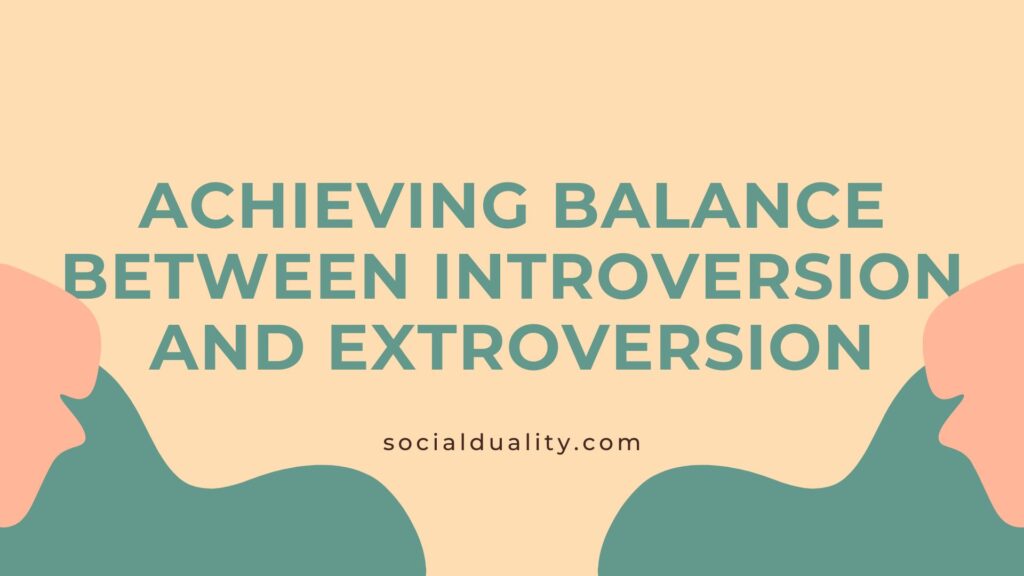Introversion and extroversion are not black and white; many of us exist somewhere in the middle, embodying characteristics of both. Becoming an ambivert, achieving a balance of introversion and extroversion, can be a game-changer. It’s about balancing your challenges and harnessing the strengths of both personality types.
Whether you’re a highly sensitive extrovert seeking meaningful connections or an introvert relishing in solitude, finding equilibrium can enhance your social life and self-care practices. This article aims to debunk the common myths about introverts and extroverts, provide self-care strategies for both, and discuss the concept and benefits of being an ambivert. Let’s journey together to find your balance in the spectrum of introversion and extroversion.
Key Takeaways
- Recognize that introversion and extroversion exist on a spectrum, with ambiverts embodying characteristics of both.
- Understand that the common misconceptions about introverts and extroverts are often false; introverts can enjoy meaningful conversations and extroverts can be reflective.
- Realize that both introverts and extroverts can enjoy socializing, but in different ways, and decision-making also varies between the two.
- Recognize the signs of being an ambivert and learn to leverage the strengths of both introversion and extroversion.
- Practice self-care strategies suitable for your personality type, whether introvert, extrovert, or ambivert, to maintain balance and prevent burnout.


Identifying Introversion and Extroversion: A Closer Look
Diving deeper into the nuances of introversion and extroversion, one can see a balance that’s often overlooked: the concept of the ambivert. Being an ambivert means you’re fluid, capable of switching between being outgoing and reserved as the situation demands. With a keen understanding of both ends of the spectrum, they can adapt and thrive in various social contexts. This versatility allows them to connect with a broad range of personalities, fostering harmony and understanding. For an illustrative exploration of this concept, consider this insightful piece on the life of an ambivert navigating a world shaped by introverted and extroverted norms.
5 Common Myths about Introverts and Extroverts Debunked
“Debunking misconceptions about introverts and extroverts” is a topic that can shed light on the misunderstood traits of these personality types. Here are five of the most common misconceptions:
- Introverts are anti-social: Introverts are not anti-social but selectively social. They prefer deep, meaningful conversations over small talk.
- Extroverts are attention-seekers: While extroverts do enjoy social interactions, they are not necessarily attention-seekers. They simply gain energy from being around others.
- Extroverts can’t enjoy solitude: Extroverts, like anyone else, can enjoy and benefit from solitude and introspective moments.
- Introverts are always quiet: Introverts can be talkative and outgoing in comfortable, familiar environments or while discussing topics they’re passionate about.
- You’re either an introvert or extrovert: Many people fall somewhere in the middle of the spectrum, known as ambiverts. Ambiverts can display traits of both personality types, depending on the situation.
For a deeper understanding of the introvert-extrovert spectrum, our previous post provides a comprehensive overview. So, remember, it’s all about balance and understanding that everyone is unique and cannot be neatly categorized.
Socializing: Introverts, Extroverts, and the Spectrum In-between
Taking the social interaction spectrum into account, it’s worthy to note that individuals can sway between extroversion and introversion. This fluidity is influenced by various factors such as mood, environment, and personal growth. With this knowledge, it becomes possible to achieve a fine balance within the spectrum, leading to healthier social interactions and personal development.
As an ambivert, you have the advantage of being able to enjoy solitude as well as thrive in social situations. You can engage in stimulating conversations at a party and also find solace in a quiet corner with a book. This flexibility allows you to adapt and respond effectively to a range of situations, providing a balanced approach to socializing.
Understanding and respecting the different social preferences can lead to harmonious relationships. Whether you identify as an introvert, extrovert, or somewhere in-between, remember that everyone’s social needs are unique and valid.


The Role of Introversion and Extroversion in Decision Making
Analyzing how introverted and extroverted characteristics influence our decision-making processes reveals fascinating insights. Introverted individuals tend to process information internally before voicing their decisions, reflecting their preference for deep, introspective thinking. Conversely, extroverts often process information through dialogue and collaboration, mirroring their inclination for vibrant, social environments.
Those who exhibit ambivert traits, however, display a unique balance in decision-making. They possess the ability to adapt their decision-making approach according to the situation, drawing on their capability to oscillate between introverted and extroverted behaviors. Interestingly, this balance allows ambiverts to navigate situations with ease, demonstrating the power of balance in decision-making.
For a deeper exploration into the dynamics of introversion and extroversion, feel free to peruse our post on understanding introverts and extroverts.
Achieving Balance: The Concept of an Ambivert
Mastering the art of ambiversion involves finding a perfect synergy between introverted and extroverted traits. Ambiverts, unlike pure introverts or extroverts, can adapt to various social settings and situations. They can enjoy a lively party as much as a quiet night in, reflecting their ability to strike a balance. This unique ability allows ambiverts to connect with a wide range of personalities, making them awesome ambiverts in their own right. By understanding and harnessing the strengths of both introversion and extroversion, ambiverts can navigate life’s challenges and gifts with ease and grace. This characteristic plays a significant role in making ambiverts highly adaptable and relatable individuals.
Are You an Ambivert? Identifying the Signs
To discover if you’re an ambivert, it’s crucial to recognize the manifestations of this balanced personality type. Ambiverts can often find harmony in their social interactions and solitude, being able to appreciate the buzz of a crowd, yet also relishing some quiet downtime. They can adapt their behavior based on the situation, showing the capacity to blend into a lively social scene or retreat into introspection when required. It’s all about balance for ambiverts, and their ability to fluidly move along the introvert-extrovert spectrum is a key sign of this personality type.
In our post, we delve deeper into the social strategies for both introverts and extroverts, which can provide further insights into the ambivert personality.
| Traits | Introvert | Extrovert | Ambivert |
|---|---|---|---|
| Social Preference | Small, intimate gatherings | Large, lively events | Balance of both |
| Energy Source | Solitude | Social Interaction | Both |
| Decision Making | Reflective, slow process | Quick, in-the-moment | Balance of both |
| Ideal Work Environment | Quiet, solitary | Busy, collaborative | Balance of both |
| Reaction to Stimulation | Overwhelmed by too much | Energized by lots | Balance, depending on situation |
For a more comprehensive explanation of what it means to be an ambivert, refer to this source.
Harnessing the Strengths of Both Introversion and Extroversion
Leveraging the qualities of both introversion and extroversion offers a balanced approach to social and personal life. Ambiverts, as we discussed in our previous article, do this naturally. They can comfortably navigate between solitude and socialization, providing them with unique advantages.
Here are five strategies to help maintain this balance:
- Practice introspection: Reflect on personal strengths, weaknesses, and preferences.
- Define boundaries: Understand personal limits to avoid burnout.
- Cultivate adaptability: Learn to adjust behavior according to the situation.
- Prioritize self-care: Extroverts might need to consciously schedule alone time, while introverts should ensure they’re not isolating excessively.
- Embrace diversity: Respect the strengths of both introversion and extroversion, in oneself and others.
Striking this balance can foster a more fulfilling, well-rounded life.
The Art of Self-Care for Introverts and Extroverts
Mastering self-care can be an art, especially when understanding the varying needs of introverts and extroverts. Balance is key, and whether you’re an introvert requiring solitude to recharge, or an extrovert who gains energy from social interaction, recognizing and respecting these needs is essential. For extroverts, solitude can be a sanctuary for reflection, while for introverts, finding comfort in social settings can be equally beneficial. The trick is not to confine oneself to a box, but to allow space for growth and adaptability. This adaptability is the essence of an ambivert – a person who embodies the best of both worlds. By acknowledging these differences, we foster better self-care habits, enriching our overall wellbeing.
Tips for Extroverts: Balancing Social Life and Solitude
Striking a balance between bubbling social interactions and peaceful solitude is a challenge that extroverts often face. To maintain this equilibrium, extroverts can consider scheduling quiet time to reflect, meditate, or simply unwind. The key is to honor your natural inclination for external stimulation while also prioritizing moments of tranquility. This ensures that you are not just surviving, but truly thriving in both public and private spheres. Remember, it’s perfectly fine to decline an invitation to a social event if you’re feeling drained. After all, even the most social butterflies need to rest their wings.
Self-Care Strategies for Introverts: Embracing Alone Time
Discovering how to find solace in solitude is a crucial aspect of self-care for introverts. By acknowledging their inherent need for alone time, introverts can establish a rhythm that supports their overall wellbeing. This might involve setting aside time for quiet reflection, engaging in creative pursuits, or simply enjoying the tranquility of nature. Achieving this equilibrium is not about isolation, but rather about respecting one’s need for personal space to recharge and rejuvenate. As Shasta’s Fog rightly highlights, finding balance in this aspect of life is integral to maintaining a healthy mental and emotional state.
| Activity | Alone Time Percentage | Social Interaction Percentage | Ambivert Balance |
|---|---|---|---|
| Reading | 80% | 20% | 50% |
| Nature Walk | 70% | 30% | 50% |
| Meditation | 90% | 10% | 50% |
| Creative Pursuits | 75% | 25% | 50% |
| Solitude Breaks | 85% | 15% | 50% |
Practical Insights from Highly Sensitive Extroverts
Gleaning wisdom from extroverts who are also highly sensitive, we find a unique blend of sociability and depth. These individuals demonstrate a remarkable balance, adeptly navigating social arenas while remaining attuned to their inner sensitivities. Their practical approach offers a roadmap for striking an equilibrium between external interaction and internal reflection.
| Practical Insights | Sensitivity Level | Extroversion Level | Balance Score |
|---|---|---|---|
| Prioritize Quality Relationships | 85% | 75% | 80% |
| Embrace Solitude Breaks | 95% | 65% | 80% |
| Choose Meaningful Social Engagements | 90% | 70% | 80% |
| Practice Mindful Self-care | 95% | 60% | 78% |
| Foster Deep Connections | 80% | 85% | 83% |
Creating a Harmonious Society: Respecting Introversion and Extroversion.
For a harmonious society, it’s essential we value both introverts and extroverts equally. A healthy balance is key, celebrating both quiet introspection and lively social engagement. This mutual respect can lead to a more inclusive, supportive environment, fostering understanding and empathy. Val Nelson, a coach for introverts, argues that acknowledging everyone’s unique contributions can enhance collaboration and productivity. By recognizing our differences, we can better accommodate the varying needs of individuals, creating a culture of acceptance. This way, each person can thrive in their own way, contributing to a balanced, harmonious society. Our diverse personality traits, when acknowledged and respected, can indeed be our collective strength.


Conclusion
In conclusion, understanding and embracing the spectrum between introversion and extroversion is crucial for personal growth and societal harmony. The journey to self-discovery starts with debunking misconceptions about introverts and extroverts. It then evolves into appreciating our unique traits and implementing self-care strategies that cater to our individual needs.
Ultimately, the goal is not to categorize ourselves rigidly but to appreciate our fluidity across the spectrum. Whether you’re an introvert, extrovert, or ambivert, remember that each personality type has its strengths and potential for growth. Embrace the spectrum and harness its power to become the best version of yourself.
Furthermore, let’s strive to foster a society that respects and values the diversity in personality types. After all, it’s our individual quirks and traits that make our society vibrant, dynamic, and truly fascinating.
What is the difference between introverts and extroverts?
Introverts often prefer solitude and deep thinking, while extroverts thrive in social settings and enjoy engaging in conversations. However, these are not absolute, and many people exhibit characteristics of both introversion and extroversion.
What are some common misconceptions about introverts and extroverts?
Introverts are often seen as shy or anti-social, and extroverts are viewed as overly talkative and attention-seeking. However, these are misconceptions. In reality, introverts value meaningful conversations and aren’t necessarily shy, and extroverts can also be thoughtful and reflective.
What is an ambivert and how does being one influence socializing and decision making?
Ambiverts fall in the middle of the introvert-extrovert spectrum, exhibiting traits from both ends. They enjoy both alone time and social interactions, and their approach to socializing and decision making can shift based on their needs and the context. They can be social when needed and reflective when required, making them adaptable in various situations.
What are some self-care strategies for introverts and extroverts?
Extroverts, despite gaining energy from social interactions, should ensure they have moments of solitude to recharge to prevent burnout. Introverts, on the other hand, should embrace their need for alone time to recharge and avoid overstimulation. This can include activities like reading, meditating, or spending time in nature.
How can understanding introversion and extroversion contribute to a harmonious society?
By understanding and respecting the different needs and preferences of introverts, extroverts, and ambiverts, we can create a more inclusive and supportive environment. Each personality type has unique strengths and contributions to offer, and recognizing this can lead to more harmonious interactions and relationships.


